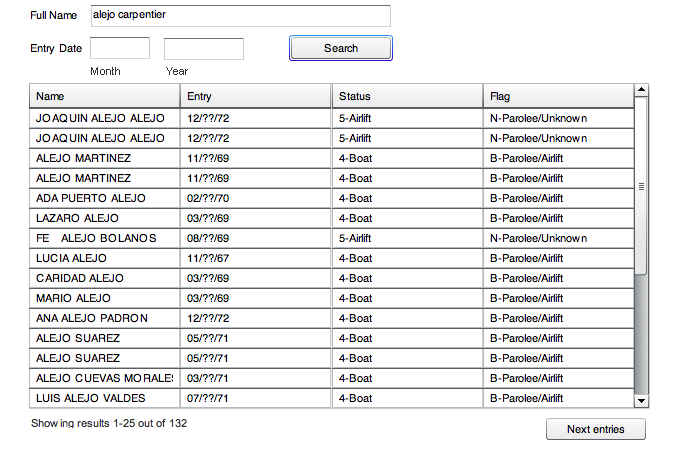Lately I've been struggling to find blog-worthy stories on the Miami Herald's website. But when I visited the main page today, I noticed something new on the sidebar: a link to an interactive map that locates art galleries in Miami and on Miami Beach. It turns out that, since 2002, Miami has hosted Art Basel, an international contemporary art fair and sister event to the fair of the same name held every June since 1970 in Basel, Switzerland. This year, the Miami Beach convention is taking place Dec. 6-9. I knew Miami had produced a number of famous artists, but when I think of Miami and art the first thing that comes to mind is Miami Ink. I had no idea the city had been hosting a prestigious and high culture event for so many years. According to Hannah Sampson's recent article about Art Basel Miami Beach, however, the art gallery scene in the city itself is still developing. Of the 260 galleries showing work at the convention, only two are from Miami. Art collectors and gallery owners say that the fair has shed light on Miami as an art community, but as a result the galleries have some tough competition. The article profiles five gallery owners from around Miami-Dade county, while the interactive map displays more than 60 art galleries, museums, fairs and organizations both on the mainland and Miami Beach. The map gives visitors important information like addresses, websites, phone numbers, visiting hours and admission fees. I think the multimedia piece as a whole is a great way for people to learn about the evolving art scene in Miami and how they can support local artists and galleries. Instead of simply reporting on Art Basel itself, which takes place every year, the Miami Herald has taken an in-depth look at how the convention has affected the art scene in Miami so far and how locals can get involved and support the community.

The National Alliance on Mental Illness offers support groups for families of individuals with mental illness.
Our third and final project for Professor Herbert Lowe's digital journalism class will be focused on mental illness in Milwaukee. With the help of Journal Sentinel reporter Meg Kissinger, my #loweclass colleagues and I will once again work in pairs to create an audio slideshow to accompany a text piece. This time around, however, we'll be reporting on the various aspects of the mental health system in Milwaukee, from psychiatrists to judges to the patients themselves. For our project, Courtney Perry and I have decided to address the issues that family members face when a loved one is diagnosed with a mental illness. This is obviously something that many people can relate to, including Kissinger herself: she wrote a touching piece about her brother Jake, who struggles with depression. According to Meg, Jake wanted to move out of his group home in Chicago and live with his sister; Meg wondered how such a move might affect not only Jake's life, but Meg's and her husband's lives as well. Meg's story makes it clear that mental illness doesn't just affect the individuals who live with it; mental illness touches the lives of entire families: parents, siblings, children, aunts, uncles and grandparents. Mental Health America (MHA) of Wisconsin and National Alliance on Mental Illness (NAMI) Greater Milwaukee both offer services to families in Milwaukee that are dealing with mental illness. NAMI's Family-to-Family Education Program is a free 12-week course for "family members, partners and friends" of individuals with mental illness, including depression, schizophrenia, bipolar disorder and personality disorders. The course is taught by volunteers whose loved ones have been diagnosed with a mental illness. NAMI Greater Milwaukee also sponsors many different support groups, including a few for family members of individuals with mental illness and those who have lost loved ones to suicide. On the other side of things, MHA of Wisconsin's Strong Families Healthy Homes Program offers a variety of services to support families when parents or caregivers are living with mental illness. The program focuses on aiding parents/caregivers in caring for their family and supporting family members in dealing with a caregiver's mental illness. One of the programs, Intensive In-Home Services, offers classes, therapy, psychiatric services, childcare, parenting assistance and transportation. It seems there is no shortage of support systems for families who are learning to deal with a loved one's mental illness. However, families have very little control when it comes to that loved one's care within a mental health hospital. The Milwaukee County Mental Health Complex has faced serious accusations of negligence in the past year. In October, Brandon Johnson died at the Mental Health Complex after nurses ignored his complaints of a broken neck. Johnson's death was the fifth this year at the mental health facility; his family demanded an investigation. Preventable tragedies like Johnson's death must make family members feel so helpless when a loved one is staying at a mental health facility. It's clear that the mental health system in Milwaukee could use some reforms, and I think whoever Courtney and I interview in the coming weeks will have plenty to say on the matter.
Yesterday in JOUR 1550 we had the privilege to meet with Meg Kissinger, a reporter for the Milwaukee Journal Sentinel. It was fascinating to learn about Kissinger's evolving career in journalism. She's covered a variety of topics, from obituaries to gossip to science, but when two of her siblings committed suicide, Kissinger began to write stories about mental illness at a time when it was an uncomfortable subject for many people. In many ways, it still is, and the mental health system has, unfortunately, remained inefficient and inconsistent. She told us that Milwaukee has the highest rate of emergency detentions in the nation, and there have been five deaths at the Milwaukee Mental Health complex this year. Through her reporting, Kissinger's goal is to find out how mental health care in Milwaukee can be improved. In preparation for her visit, Professor Lowe requested that we take a look at Kissinger's excellent multimedia piece Imminent Danger, which focuses on how the health care system for patients with mental illness got so broken and how psychiatrists and the government are trying to fix it. Kissinger interviewed mental health advocates, psychiatrists, family members of people with mental illness, the husband of a victim at Virginia Tech and a victim of the shooting at Tucson. What really struck me about Kissinger was her positive energy. Despite the struggles she's faced with her family and her own health, and despite the heavy nature of the topic she covers, she has a very upbeat personality and she even had the class laughing at her anecdotes and wisecracks throughout her visit. Not only is Kissinger a great role model as a journalist; I believe she's also someone to look up to for maintaing a strong will and a positive attitude in the face of personal challenges. This semester we'll be working with Kissinger on our own stories about mental health in Milwaukee, and I can honestly say I'm looking forward to it.
 Florida ranks relatively low in all four economic indicators. With two debates already behind us and the presidential election less than a month away, this week I thought I would take a look at the Miami Herald's election coverage. Like Wisconsin, Florida has often been a swing state in presidential elections, and its status is no different for this year's election between Barack Obama and Mitt Romney. As a result, I was expecting to find a lot of news about both candidates' triumphs, gaffes and policies. In terms of story content, I was a little disappointed. There were very few recent articles on national politics, and the ones I did find weren't unique to the Herald. Many were written by reporters from the McClatchy News Service or the Herald/Times Tallahassee Bureau. There was, however, a great article about a poll which showed Romney moving ahead of Obama with likely Florida voters due to each candidate's debate performance. The story seemed to exemplify Florida's swing state status, revealing Romney's sudden 51-44 percent advantage among Florida voters. What caught my eye, though, was the Herald's comprehensive and interactive infographic about swing state economics. The graphic shows the United States map with each of the 14 swing states shaded in according to how that state fares in one of four economic indicators: jobs, housing, pocketbook and output. The last tab, rankings, measures each swing state's economic standing in relation to the other states. I was impressed with the infographic because the creator, Marco A. Ruiz, managed to pack a lot of information together in a very visually appealing and interactive way. It's interesting to observe how the swing states are faring economically compared to the rest of the country and how the states have improved or worsened since 2008. After the election is over, I will most definitely be going back to this graphic to search for a pattern in how the swing states' economic standings might have influenced voters.
 The Freedom Flights database is the only public record of refugees that fled to the United States during the Cuban Revolution. This week, as we collected our audio and put together a final structure of our One @ Marquette projects, Professor Herbert Lowe asked us to find something exceptional about our beat websites. At first I wanted to write about El Nuevo Herald, The Miami Herald's Spanish-language companion. I thought it was pretty unique for a newspaper in the United States to have such close ties to a newspaper that's published in Spanish and reports on issues in Cuba, Venezuela and Colombia. But Professor Lowe wanted us to write about "something screaming digital journalism," and El Nuevo Herald is just a sister newspaper to The Miami Herald, and while I think that's something to be commended, it doesn't quite "scream" digital journalism to me. I looked around The Miami Herald's website a little more and was surprised but pleased to find a special page dedicated to The Herald's 10-part series on the Cuban Revolution; it seems to have been posted in late 2008 to commemorate the 50th anniversary of the end of the Revolution. The producers went so far as to create an interactive graphic which visitors can use to navigate through the different parts of the series: 50 Years: Then and Now, The Freedom Flights, The Freedom Tower, "Plantadas," Nostalgia (El Encanto), Society (Race-based clubs), Revolution Anniversary, The U.S. Reaction, Yanqui Comandante, and The Insider. By clicking on the tabs, visitors can read a description of that particular aspect of the project and click on links to relevant articles and multimedia elements like photo galleries and videos. One of the most prominent aspects of the project is the documentation of Cuban refugees' flights to the United States, referred to as the Freedom Flights. The U.S. government sponsored the resettlement of hundreds of thousands of Cubans, who entered the country through the Freedom Tower in Miami. Visitors to the page who took part in the Freedom Flights are encouraged to share their stories and videos, and The Herald has compiled a number of video packages profiling individual refugees. The project creators did an excellent job of combining hard news and feature stories with multimedia to take a look at how the Cuban revolution has shaped Cuban and American societies. What impressed me most about this project was the Freedom Flights database, the only public record of the resettlement program. Visitors can type in the name of a friend or family member who fled from Cuba to the U.S. in the Freedom Flights and see what date he or she arrived. This is such a great way for people to connect with their roots and learn a little about their personal history and the history of our nation.

The Milwaukee Neighborhood News Service tells stories that may not receive attention from big media outlets.
On Wednesday, our JOUR 1550 class had the privilege to meet with Sharon McGowan, the editor-in-chief of the Milwaukee Neighborhood News Service. MNNS is an online news website that reports on events, organizations and issues within Milwaukee communities, often focusing on areas that don't get thorough news coverage from major news outlets. McGowan started MNNS in March 2011, and the website now covers 15 Milwaukee neighborhoods. I'd heard of MNNS before, since they are partnered with the Diederich College of Communication and their headquarters are located on the fifth floor of Johnston Hall. However, I'd never considered the important role they play in giving a voice to Milwaukee's underrepresented communities. McGowan said that many of the neighborhoods MNNS covers will only end up in the news because of a crime, and that one crime might lead to five or six stories. To give us an example of the types of stories her reporters tell, McGowan showed us a video, produced by Andrea Waxman, about a group of young moms who have come together to help others in their community: McGowan said that the "ultimate goal" of MNNS "is to improve the quality of life in the communities [they] cover." We'll be writing our own stories for the website later on this semester, breaking off into groups of two to profile community organizations in the neighborhoods MNNS covers. I can't wait to find out what our assignments will be; I think everyone can benefit from these projects, since we'll get some experience doing journalism in Milwaukee, rather than confining ourselves to news on campus and downtown, and local organizations will have the opportunity to share their stories.
 The last time The Miami Herald posted an audio slideshow was in the aftermath of the 2010 Haiti earthquake. When we were first given our beats for JOUR 1550, one of the things that struck me about The Miami Herald was its section dedicated to multimedia. The videos and photos don't come as any surprise; it would seem that most newspapers are delving into these aspects of online journalism. The multimedia section also contains links to podcasts from WLRN, Miami Herald's public radio station. What I'd like to focus on, though, is the Herald's use of audio slideshows. We're working on our own audio slideshows for our One @ Marquette projects, so I was curious to see what my beat had to offer in that respect. The New York Times' One in 8 Million series has certainly set a high standard, and I regret to report that The Miami Herald doesn't have anything quite so impressive. The most recent audio slideshows are pieces from two of the newspaper's photographers, describing what it was like to cover the aftermath of the earthquake in Haiti. The photographs are moving, often overwhelming in their emotion; unfortunately, I was distracted by the use of vertical photos and different dimensions, which emphasized to me the importance of being consistent in my photography so as not to detract from the emotion of the photos. The Miami Herald's audio slideshows are often more informative in nature, rather than telling any personal stories. For that reason, I found many of them to be a little boring. However, there is one slideshow that particularly impressed me, "After Guantanamo," because the reporter used a lot of natural sound, which gave the piece a very strong sense of place, and it's clear that the photographer must have had to work hard to take meaningful shots, since censors at Guantanamo decide which photos are okay to use and which are not. Overall, The Miami Herald has an impressive selection of multimedia, including audio slideshows. However, it seems they haven't posted one in a while, and some are better than others. The website seems to concentrate its efforts more on photo galleries, videos and podcasts.
When I heard our next beat assignment for #loweclass was to blog about our website's coverage of NFL opening weekend, I groaned--loudly. Of all the things that interest me, football doesn't even make it onto the list. And despite having lived in two sports-obsessed cities, Chicago and Milwaukee, I know very little about sports journalism. With this in mind, observing The Miami Herald's coverage of the Dolphins this weekend was as easy for me as understanding a game of cricket. Even though I felt a little out of my league with this assignment, it was still interesting to see how The Miami Herald chose to report on their city's football team. First, I did a little research and learned that although the Dolphins are relatively new to the NFL, they've won two Super Bowls and completed the only perfect season in NFL history. That sounded like a legacy worthy of some pride. So I was surprised when, on Saturday, the sports page's top story wasn't about the Dolphins' upcoming game against Houston on Sunday; instead, the headline lamented the Miami Hurricanes' defeat against Kansas State. The Dolphins were relegated to the headline below that, a rather opinionated article about the Dolphins' need for "pass-rushers." This gave me the impression that Miamians might be more interested in college football than they are in their NFL team. Again, I don't know much about sports journalism, but the day before a big game I would want to read articles about team dynamics, game strategy and how players match up against their rivals. On Sunday, the Dolphins' game against the Houston Texans was front and center on both the sports and home pages. There was a scorecard below the header, and the top story linked to a live blog of the game written by Armando Salguero. Such tools are helpful for casual and devoted fans alike, especially when some people might not be able to watch the game live; I think it's great that the Herald made them so accessible. However, I did notice a few commenters criticizing Salguero for his spelling and grammatical mistakes, most of which seem to have been fixed before I read the blog. It looks like The Miami Herald might have a few things to work on in terms of professionalism on their reporters' blogs; I'll put the lack of NFL enthusiasm down to the Dolphins not appearing in a Super Bowl since 1985. But I am impressed by the site's user-friendly approach to reporting the highlights of live games and offering post-game reflections. Still, you won't catch me reading any football articles this season.
 It's hard to tell text apart from hyperlinks on the Miami Herald home page. Okay, I'll admit it: Most of my news comes from Twitter. True, the tweets link to news websites, but in general I have found news sites to be too cluttered and difficult to navigate for my tastes. Some exceptions include the Milwaukee Journal Sentinel and TIME. In my opinion, when it comes to website design, simple and clean is best, with a strict adherence to the rule of thirds. Until Professor Herb Lowe assigned us our digital beats for this semester, I had never once been to The Miami Herald's website. Upon my first cursory glance of the front page, I felt a little overwhelmed. There is a lot of text, which appears to be the same color as the links. This is problematic because visitors should easily be able to tell what is text and what is hyperlink. Instead of a simple three-column layout, the designers went with a cramped four columns. The left side of the page is graphic-heavy, while the right side consists of text and links. Those columns end about a third of the way down the page to make room for another series of sections, positioned horizontally. Here, the visitor can find multimedia, a news "grid," community news, opinions, and a marketplace. These five sections can be moved up or down if the visitor wants to modify their view of the front page, which is rather new to me; I don't think many news sites allow visitors to do that. At the top of the page, there is the typical navigation bar to aid movement through the different beats like news, sports, and entertainment. There is even a sub-navigation bar to help visitors narrow down their search, though it would be more helpful if the sub-navigation appeared when the cursor hovers over the top navigation, like JSOnline and The Chicago Tribune. The "Community News" drop-down menu also makes it easy for visitors to find the news that is relevant to their location. Many of the top stories have photographs, slideshows, videos, or some combination of the three. The story about Michelle Obama's speech at the Democratic National Convention, for example, has a sidebar with a slideshow and two videos, squeezing the text into a rather small column. Regardless, the slideshows add a nice touch of interactivity and multimedia to the site. I also like that the writers mention Mayor Julian Castro, the first Latino keynote speaker in DNC history, and emphasize the convention's diversity. Miami has a very high Latino population, so it's clear that the Herald is keeping that audience in mind. Each article has a discussion section, where visitors can choose to connect with their social media accounts and leave comments. All articles have buttons to share via Facebook, Twitter, and Google+, which is no surprise in this day and age. The multimedia section is actually rather impressive, boasting a collection of videos, photos, audio slideshows, and podcasts. If I lived in Miami, I probably wouldn't visit the Herald's website on a daily basis, simply because it is such a pain to navigate. However, I can appreciate the newspaper's endeavors to use multimedia in a creative way and give national stories a local spin.
|







 RSS Feed
RSS Feed